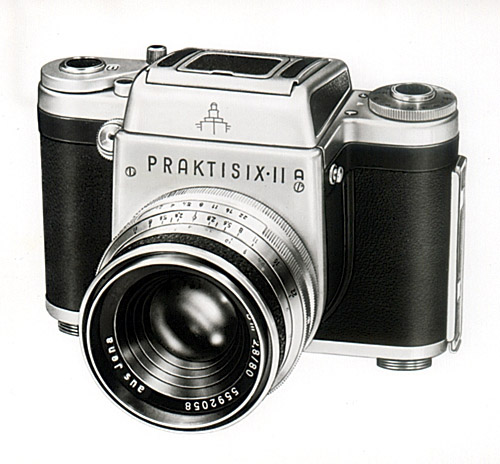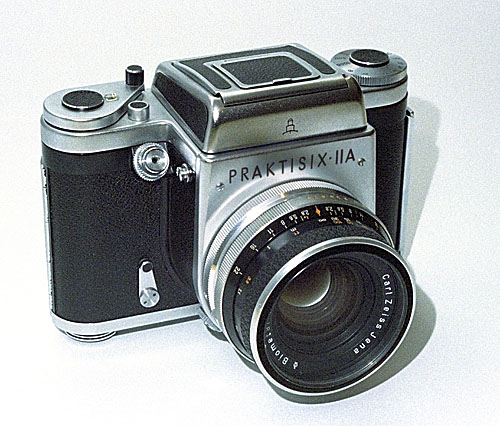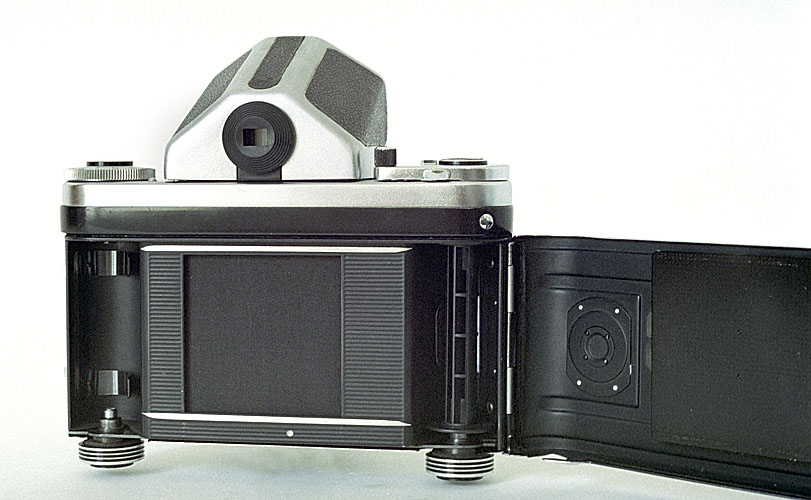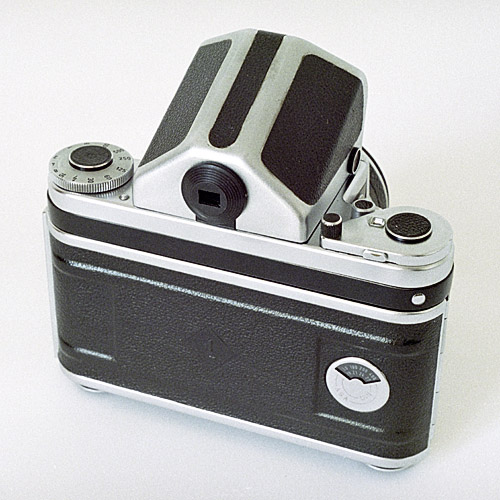by TRA
The History of the Pentacon Six
The Praktisix IIA
Dates: 1965-1966 (prototypes
in 1964)
(information provided by a collector)

Another picture that the factory sent me in 1981.
This is an early Praktisix IIA in which an A has been added to what
was obviously an original Praktisix II faceplate.
Features

This later Praktisix IIA has a re-designed faceplate. [C396_10.jpg] |
This was largely as the Praktisix II but with a flash
connection socket lock (just about visible behind the lens on the image
to the left) and the pull-out spool end supports that projected below the
bottom of the camera and that had appeared on some of the late-production
Praktisix II cameras.
The camera chassis size was identical with the previous model, so the spool end knobs increased the overall height and prevented the camera standing upright on a flat surface. A third foot was apparently designed for the tripod socket, but it is virtually never listed by the manufacturer and is extremely rare. It was necessary to wait until the arrival of the Exakta 66 in the 1980s for this omission to be corrected. The carrying case now only produced in black was modified with the addition of two holes in the base to accommodate the spool knobs. A bulbous Perspex cover on the frame number window on the advance lever magnified the number beneath it and prevented the entry of dust and debris. The camera on the left is shown with the Carl Zeiss Jena 5-element 80mm f/2.8 Biometar lens. The first batch of 7,000 of this lens in the Praktisix mount was completed on 24th March 1959 (Thiele, p 163). This remained the standard lens for the next 30 years. |
| The fluted design of the film guide rails that had been
introduced with the Praktisix had been replaced by straight rails.
This change was retained for all subsequent versions of the camera.
A button-operated locking pin was added to the top plate, to prevent accessories that were merely slid into place (the waist level finder and the magnifier head) from accidentally sliding off. (The prism had its own locking mechanism.) If you have very sharp eyesight, in good light you can just detect an X impressed into the leatherette by the flash socket with some of these cameras. In the 1980s I was informed by a factory source that there were also some technical design changes not visible to the user. Most obvious was the modification of the film loading system which re-introduced the feet on the base of the camera which can be locked out by pulling and twisting to facilitate insertion and removal of spools. This system, which had last been seen on the Meister Korelle, was also incorporated in some late production numbers of the Praktisix II in 1965, as can be seen in one of the photos on the Praktisix II page. |

Inside the back of a Praktisix IIA Note the simplification of the guide rails and pressure plate. [C447_33A-p2A.jpg] |

The film reminder dial on the camera back can be seen here
and the new bulbous perspex cover that magnified the frame number and
shielded it from dust.
You may also just be able to see in the centre of the back the 1
that was part of the Q1 symbol
that was awarded over a number of years by the East German government
for products deemed to be of the highest quality.
[C447_21A_p2A.jpg]
This body also has the slightly-improved plain prism, although this prism is probably newer than the camera.
Following KWs incorporation into VEB Pentacon, it was decided to re-name the camera when the next version was launched.
To go to the Bibliography, click here.
To go on to the next section, click below.
19 The Pentacon Six
To go to the beginning of the history section, click here.
To go to introduction to the cameras, click here.
To choose other options, click below.
Home
© TRA August 2010, Revised October 2010